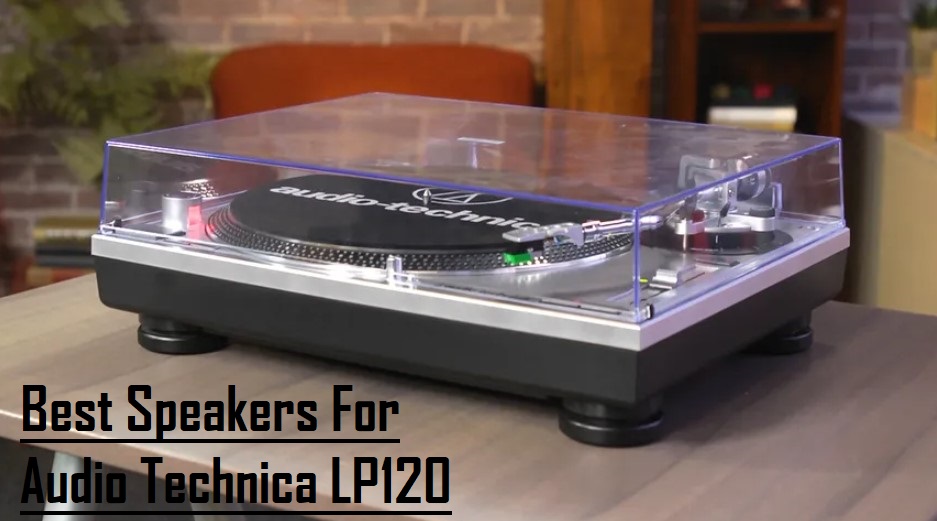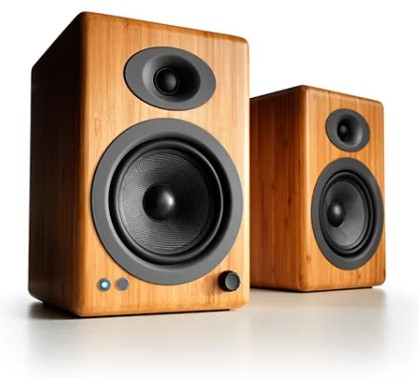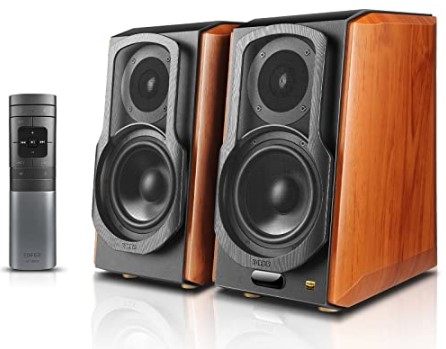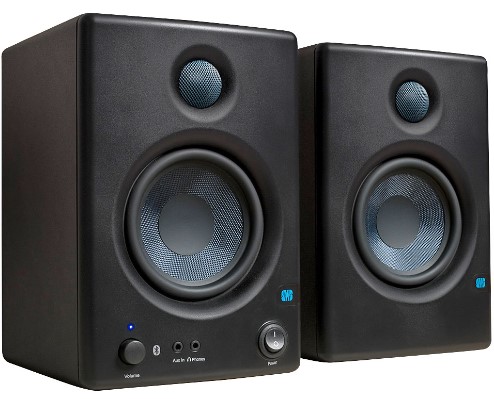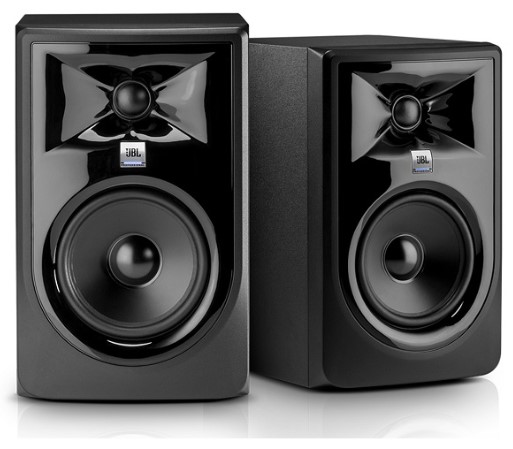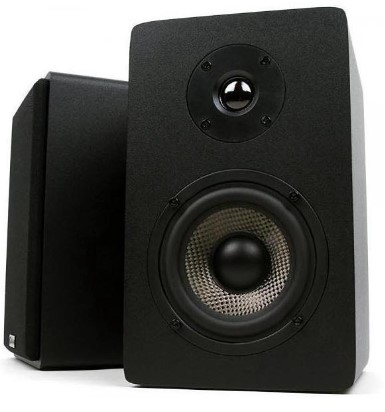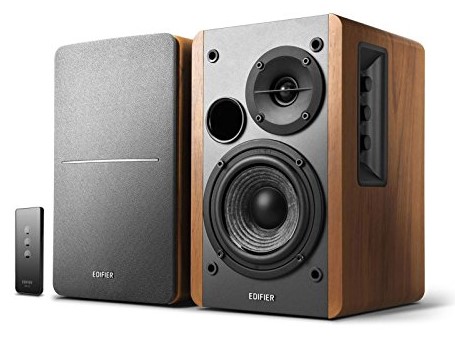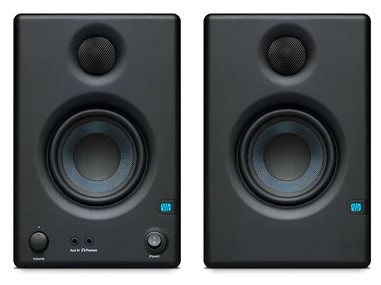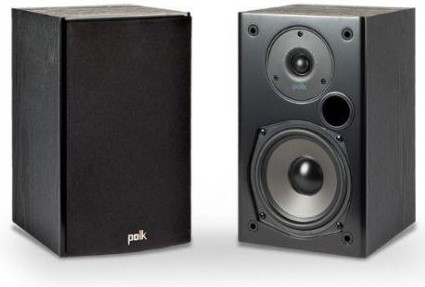If you want to make your Audio Technica turntable sound even better, you’ll need a nice speaker, because Audio Technica turntables are primarily designed for novices. You should bear in mind that when selecting the best speakers for audio technica LP120 or any of your turntables, you do not need to spend a lot of money on speakers.
Why do you need Speakers for Audio Technica LP120?
There are some self-contained record players with built-in speakers on the market. Most good turntables, on the other hand, are sold separately from speakers. Component record players, such as the Audio Technica-LP120, require speakers and an amplifier to function.
The simplest configuration involves using an RCA connection to connect your turntable to a pair of powered speakers. The RCA cable is connected to the rear of the Audio Technica-LP60 and Audio Technica-LP120. Simply connect your turntable’s RCA cord to the powered speaker’s RCA input. And there you have it!
Receivers/ Powered Speakers/Studio Monitors/Passive Speakers/Active Speakers? Which one should you choose?
Does it really matter? Absolutely yes!
Receivers: Volume control is not available on separate component turntables. This means that the volume must be controlled either through the speakers or through the receiver.
Receivers are useful because they allow you to control several aspects of the sound during playback, including volume, equalization, and balance, as well as having a remote control. They are, however, pricey, and speakers are still required.
Powered Speakers: You won’t be able to manage the equalization of the music if you use powered speakers instead, and you’ll have to regulate the volume from the speakers without a remote control. This does not bother me, but it is a matter of personal preference.
Studio Monitors: The equalization of recording studio monitors is flat because they are designed to reproduce the recording mix as accurately and clearly as possible Well, I don’t mind the flat equalization, but keep in mind that you won’t have perfect control over the sound if you use studio monitors. As a result, you save space and money while losing control of the sound.
Passive Bookshelf Speakers: Because they don’t have built-in amplification, they’re the most adaptable (and usually the cheapest) sort of bookshelf speaker. This implies that to play, the turntable must either have a built-in phono preamp and powered amplifier or be connected to external components.
Powered Bookshelf Speakers: These are precisely what you’d expect: they’re “powered,” which means they have their built-in amplification and require power to operate. In most cases, only one of the speakers is amplified (the “master”) and must be connected to the passive speaker (the “slave”) via wire. You can connect the turntable straight to a set of powered speakers if it has a built-in preamp.
Active Bookshelf Speakers: These are similar to powered bookshelf speakers, however they are more advanced. Individually amplified, the speakers come with a variety of built-in connectivity choices, including Bluetooth, Wi-Fi, and optical.
A turntable with a built-in preamp can be connected directly to active bookshelf speakers. You can generally connect the turntable straight to the active speaker if it doesn’t have a built-in preamp or powered amplifier.
The good news is that I’ve found some amazing powered speakers that complement the AT-LP120 flawlessly. And one of them (which I ended up getting) is just fantastic. So keep an eye out.
Best Speakers for Audio Technica LP120 At A Glance
- Audioengine A5+ 150 watt Stereo Speakers Pair – Best Premium Powered Speakers
- Klipsch R-51PM Powered Bluetooth Speaker – Klipsch’s Best Powered Bluetooth Speaker
- Edifier S1000DB Audiophile Active Bookshelf Speakers – Best Bookshelf Speakers for Audiophiles
- Presonus Eris E4.5-4.5 2-way – Best Powered Near Field Studio Monitor
- JBL Professional 305P MkII Next-Generation – Professional Best Powered Studio Monitor
- Micca PB42X Powered Bookshelf Speakers – Best Active Powered Bookshelf Speakers
- Edifier R1280T – Best Active Near Field Studio Monitor
- Presonus Eris E3.5-3.5″ – Professional Pair of Multimedia Studio Monitor
- Polk Audio T15 100 Watt Home Theater Bookshelf Speakers – Best Budget Home Theater Bookshelf Speakers
Audioengine A5+ 150 watt Stereo Speakers Pair
Best Premium Powered Speakers
SIZE (W/H/D): 7.75” x 7” x 10.75”, WEIGHT: 25 lbs (11.33 KG), WOOFER SIZE: 5” Aramind Fiber with advanced voice coils, TWEETER SIZE: 0.75” silk dome with neodymium magnets, INPUT: 3.5mm RCA L/R, OUTPUT: RCA variable & USB (Power/charge), POWER OUTPUT: 150 W, FREQUENCY RESPONSE: 50 Hz–22 kHz (± 1.5 dB), SENSITIVITY: 95 dB, AMPLIFIER: Class AB Analog (2 x 50 Watts RMS)
The Audioengine A5+ is one of the greatest audiophile speakers available. It achieved the top of our list of the best speakers for Audio Technica LP120 due to its outstanding combination of features and excellent quality.
System Performance
As you may be aware, Audioengine manufactures a variety of high-quality speakers that inspire people to listen to music daily. This is it, I’m telling you right now, for the acoustic person looking for high-fidelity audio sound.
There isn’t a more powerful powered speaker for your Audio Technica or vinyl than the Audioengine A5+.
Built-in Amp
They have a built-in completely analog amplifier. As a result, the entire music signal route, from the record player to the speakers, is completely analog. The fact that vinyl records are a true analog format adds to the authenticity of the vinyl record listening experience.
Vinyl records provide a smooth, rich, and natural sound since they are completely analog. Except these, a digital amplifier is used in almost all powered speakers.
Versatile Pick
I’ve been using these for a couple of weeks and they sound rich and full. I’m not sure why I used to have awful sounds in my house. These are not in the same class as my old Logitech 2.1 system, which had large subwoofers and separate tweeters.
The rich integrated mids were always absent from Logitech 2.1. Now that I’ve connected my Audioengine A5+ to my Audio Technica Vinyl, everything sounds crisp and full.
This set of speakers has been in my possession for about a year. The sound is fantastic. The mids and highs are very clear. The vinyl, piano, cymbals, and percussion instruments have a fantastic sound. My 14″ x 24″ great room has excellent bass, thus I don’t feel the need for a subwoofer.
According to Audioengine, the quality of your listening experience will improve as the speakers get older, and I believe this is accurate. Because I have them on a bookshelf, I put a tiny piece of foam under each speaker to keep the shelves from rattling when they’re turned up loud. These can be quite loud, far too loud for my living room. Do not be hesitant to acquire this item.
PROS
- Looks and sounds great.
- Genuine Hi-Fi product made in the United States.
- The company designs and manufactures its own drivers and essential components.
- Fully analog design with built-in amplifier.
- Cabinets made of MDF wood that were handcrafted.
- Shielded from magnetic fields.
- With a rear-ported waveguide, this is an advanced tuned cabinet.
CONS
- There is an additional fee, but this is to be expected for audio with such high-end qualities.
- A subwoofer may still be required for complete audio frequency coverage.
Why should one go for Audioengine A5+?
We chose Augioengine A5+ for a number of reasons. Because these are the best bookshelf speakers on the market, they can fill any space with magical sound. These offer excellent sound quality, a strong bass punch, and a variety of connection choices, making them ideal for Audio Technica Vinyls and percussion instruments.
Klipsch R-51PM Powered Bluetooth Speaker
Klipsch’s Best Powered Bluetooth Speaker
SIZE (W/H/D): 7” x 13.3” x 9.12”, WEIGHT: 10.6 lbs (4.8 KG) WOOFER SIZE: 5.25” Copper spun Magnetically Shielded IMG Woofer, TWEETER SIZE: 1” Aluminum Diaphragm Compression Driver mated to 90o x 90o square TracTrix Horn, POWER OUTPUT: 120W/140W (Continuous/Peak), INPUT: USB digital/BT wireless/Phono or Line Analog/3.5mm analog/Optical digital, OUTPUT: 1 x RCA line level output for connection to subwoofer, FREQUENCY RESPONSE: 68 Hz–21 kHz (± 3dB), CROSSOVER FREQUENCY: 1663Hz, ENCLOSURE TYPE: Bass-reflex via Rear-firing Port (MDF)
It can be tough to find a speaker setup that meets your demands if you live in a tiny flat; anything you choose must be compact, have a lot of inputs, provide powerful, precise sound, and function wirelessly. While soundbars are frequently a good solution for most people in those circumstances, they rarely equal the soundstage and image of a decent set of stereo speakers.
Klipsch R-51PM is a terrific choice for individuals who desire superior sound or simply like the look of bookshelf speakers.
System’s Performance
The Klipsch R-51PM is a set of changeable controlled speakers of good quality. They emphasize the PHONO installation and regular PHONO category. They have a Klipsch mill run and appearance, which has helped them gain a large following all across the world.
The Klipsch Reference R-5IPMs may appear to be little loudspeakers, but they are a complete hi-fi system with 60 Watts per channel, an array of inputs, and a remote control. They’re worth knowing about if you’re looking for a low-cost all-in-one with some unique features.
Design & Build
Klipsch’s renowned horn tweeters and cooper-colored woofers are featured in the R-51PM. The magnetic fabric covers hide this beauty out of the box, but they’re easy to remove and replace. Furthermore, whether the fabric coverings are on or off, the speaker’s sound is unaffected.
Everything about the build quality is exactly what we’ve come to expect from a powered speaker in this category. The fit and finish are excellent, and the connectors are of good quality. Our only criticism is the black vinyl cover on the cabinets. These cabinets might not look as attractive as some of the competition, but they are wrapped around a dense MDF genuine cabinet, which gives a wonderful base for the Klipsch drivers.
Sound Quality
I began by connecting our Oppo BDP-205D Universal player’s digital optical output to the Reference R-51PMs for CD playback from a decent source. This ‘sort of’ went off without a hitch and was rather stunning.
These powerful speakers can connect to anything, including a turntable, television, computer, cell phone, and more.
These powerful speakers are your new best buddy, with an inbuilt phono preamp, Bluetooth wireless technology, digital optical, analog RCA, and USB inputs. Again, there was considerable glare; the tweeter is forward, but that’s where all the detail and projection comes from.
I hope this information is useful, and these powerful stereo speakers, as well as the turntables, are well worth the money, especially the Audio Technica LP120! Before these, I purchased a lot less expensive set of speakers from a rival brand, and there is no comparison; the Klipsch’s entire build and sound quality are superior!
I have no complaints about not being able to hear speech on television from any programme or station, even at a very low volume. These speakers sound incredibly clean and crisp, and they’re amazing in that aspect.
PROS
- A Large Sound Stage
- There are several Inputs.
- It is Simple to Use.
- A built-in Phono Stage is included.
- The sound quality is good and the price is reasonable.
- Speaker Placement is Ideal (triangle stereo setup).
CONS
- There are no style modification options.
- There are no wood finish possibilities.
Our Verdict for Klipsch R-51PM
After spending many weeks with the Klipsch R-51PM bundle, we were thrilled with it. We like the R-51PM over soundbars in the same price range since it has more input options and adaptability. They also sound great, reaching extreme volumes without distorting.
Edifier S1000DB Audiophile Active Bookshelf Speakers
Best Bookshelf Speakers for Audiophiles
SIZE (W/H/D): 8” x 13.5” x 10.5”, WEIGHT: 20.9 lbs (9.48 KG) WOOFER SIZE: 5.5”Aluminum, TWEETER SIZE: 1” Titanium, INPUT: Aux/Optical/PC/Coaxial and Bluetooth 2.0, POWER OUTPUT: 120 Watts RMS, FREQUENCY RESPONSE: 48 Hz–20 kHz (± 4B), SENSITIVITY: 85 dB, AMP POWER: 2 X 60 watts RMS
If you want something less expensive than the Audioengine speakers, this is a wonderful option. They’re also a little bigger than the Audioengine’s. And it looks fantastic.
This is another highly respected powered speaker from one of the industry’s largest speaker manufacturers. Edifier S1000DB comes straight to the 3rd spot of the best speakers for Audio Technica LP120.
Design Quality
If you’re familiar with Edifier as a brand, you’re probably aware that the majority of their designs are quite straightforward. Most individuals would have problems distinguishing between different models if you put their whole lineup side by side.
What exactly does this imply? Two MDF panels are sandwiched between a composite body and are covered with natural finish vinyl. To put it another way, the front, top, and back are all built of high-quality grey composites.
The S1000DB’s front panel is angled, which sets it apart from other Edifier designs. This was done to improve image projection, but it also gives them a distinct visual appeal.
Versatile Connectivity
The first thing you’ll notice about these speakers is their extensive range of connections: PC / Auxiliary / Optical / Coaxial / Bluetooth aptX, there’s something for everyone’s interests and demands. We used a dual RCA audio connection to link them to the TV, and then we used Bluetooth to listen to Spotify directly from our tablets or smartphones.
Sound Performance
The highs are distinct and potent. The mids are nicely defined, and the lows are well defined, and if you like rock music, you will enjoy them. At all frequencies, performance is generally excellent.
You won’t be able to blast them out without causing a ruckus among your neighbors. They have such a great capacity that you will be able to use them even in the largest rooms.
Build Quality
For the price, the build quality is on par with, if not better than, my Klipsch or audiogenes, with great attention to detail and good fit and finish. I was concerned that the photo of the wood would be too “Okay” for my liking, but the color was much warmer than it appeared in the pictures, which was a pleasant surprise.
These items are quite heavy! Even without the amplifier, the speaker is quite heavy for its size. They didn’t scrimp on the cabinet’s material or construction quality. The one thing I don’t like about it is that there are no grill tabs around the tweeter, which makes it feel flimsy.
The Edifier S1000DB is most likely the optimal balance of price, performance, and features. They can broadcast deep bass down to 48 Hz (- 4 dB). The Edifier S1000DB is marketed as Edifier’s premium speaker. Furthermore, it is reasonably priced, making it an excellent match for the AT-LP120.
These speakers have revitalized my listening experience when paired with my Audio Technica LP120 and NAD Pre-amp; Radio Paradise also sounds great.
They can get fairly loud, and I’d call them efficient speakers. I don’t think I’ll ever turn them up past 75% because they’re already too loud for me. To maximum volume, they sound flat and undistorted. There were almost no drawbacks that I could find with these. A+ To edifier for keeping these inexpensive while maintaining high sound and construction quality.
PROS
- Deep and warm bass, audio clarity/accuracy/detail
- Speakers who are engaged.
- Bluetooth v4.0 with aptX wireless communication and wired interface (optical/coaxial/dual RCA).
- Appropriate for high-end applications.
- The tone can be adjusted.
CONS
- At this price point, there aren’t many alternatives for customization.
Why did we choose Edifier S1000DB?
We’re sure Edifier had to make some compromises to keep the price of these speakers low. Unless you want to dive too deep into the mechanics, it doesn’t notice. If you’re searching for low-cost powered speakers that match the AT-LP120 exactly, this is an excellent option. These are possibly the best value for money when it comes to budget handling.
Presonus Eris E4.5
Best Powered Near Field Studio Monitor
SIZE (W/H/D): 6.4” x 9.5” x 7”, WEIGHT: 13 lbs (5.9 KG) WOOFER SIZE: 4.5” woven composite kevlar, TWEETER SIZE: 1” Silk Dome, INPUT: 1 x Stereo 1/8”, 2 x Balanced 1/4” TRS, 2 x unbalanced RCA , RATED POWER: 50 Watts, FREQUENCY RESPONSE: 70 Hz–20 kHz, CROSSOVER FREQUENCY: 2.8 kHz, SENSITIVITY: 100 dB, AMPLIFIER: Class AB-50 watt, CABINET: Vinyl Laminated, Medium density fiberboard
Another high-quality speaker that works well with the Audio Technica LP 120 turntable is the Presonus Eris E4.5. Studio monitors come in a wide range of prices, but if you’re on a tight budget, the E4.5 is an economical entry-level alternative. The Presonus Eris E4.5 has a lot of great features, especially for the price. Let’s look at the specifics to discover what these low-cost speakers can do.
Sleek Design
The design seems simple in most of the cases. PreSonus, on the other hand, chose a fairly appealing exterior design. Eris 4.5 will blend nicely with almost any environment. The cabinets are built of ordinary MDF and have a simple style. There are no grilles on the primary drivers, however tweeters have a built-in tiny grille.
The E4.5 BT’s lightness is immediately apparent: the pair weighs only 6.4 pounds, with the left speaker weighing slightly more than the right due to the 25-watt-per-channel amplifier, controls, and connectors. The fact that these speakers are lightweight does not imply that they are of low quality.
Top-Notch Sound Quality
The Presonus Eris E4.5’s sound quality is surprisingly nicely balanced. These provide an excellent neutral response, which is ideal for audio mixing, mastering, and percussion instruments like types of vinyl, turntables, etc.
The highs are distinct. The mids, meanwhile, are well-rounded, with a full and accurate profile. The sound quality of the vocals and instruments is comparable to speakers that cost much more.
Unfortunately, the low end falls short of the mids and highs in terms of quality. They lack warmth and richness, despite their abilities. Still suitable for use with your Audio Technica LP120 or any other turntable.
Strong & Robust Build
The Presonus Eris E4.5 is very light. At first sight, this caused me doubt that the build quality would be bad. Fortunately, this is not the case. Despite their small weight, they appear to be durable and capable. The vinyl laminated fiberboard is appealing and does not exude a sense of cheapness. These ought to be able to withstand the test of time. Extra attention to detail like RF interference shielding is a pleasant bonus.
As is the “soft start” feature of the amplifier. This eliminates the all-too-common popping that occurs when some monitors are turned on. These monitors have a lot to offer for a low-cost monitor. The price is misleading since it conceals the quality of these monitors.
Flexible Connectivity
Flexible input options are the best aspects of these Eris E4.5 you can utilize any source with a line input. These inputs assist you to enjoy your work without bothering your homies. Use these woofers with 1 x 1/4-inch TRS and RCA connections as well as front-panel 1/8-inch stereo inputs to play games, listen to music, create content, or any other line-level source.
Great price! And there is no hum, hiss, or buzzing as some people claim. Straight flat, clear, and well-defined sound! Native Instruments Komplete Kontrol, Audio Technica LP120, and Arturia Keyboard recording equipment are the tools that I’m using with this little monster. I’m amazed! A Sub Woofer may be used if a bass is vital for general listening.
PROS
- The price is reasonable.
- The sound quality is excellent.
- The design is appealing.
- Build quality is excellent.
- The tone is very impressive.
- Adaptable features.
- Control panel for frequency.
CONS
- Uneven Low-end.
- Can’t equal the bass response of larger speakers.
Our Verdict for Presonus Eris E4.5
Because these woofers are lightweight, portable, and simple to use, they are one of the best choices for people nowadays. Its input selections are excellent, and the best part about it is the wireless Bluetooth activity, which is also compatible with the Audio Technica LP120XUSB, which is also enticing people to get this gear.
JBL Professional 305P MkII Next-Generation
Professional Best Powered Studio Monitor
SIZE (W/H/D): 7.3” x 11.7” x 9.1”, WEIGHT: 10.43 lbs (4.73 KG) WOOFER SIZE: 5”, TWEETER SIZE: 1” Soft Dome, COVERAGE PATTERN: 120o x 90o, INPUT: Balanced XLR and 1/4″ TRS, RATED POWER: 82 Watts, FREQUENCY RESPONSE: 49 Hz–20 kHz(±3 dB), FREQUENCY RANGE: 43 Hz–20 kHz (-10 dB), CROSSOVER FREQUENCY: 1725 Hz, SENSITIVITY: 100 dB, AMPLIFIER: Class D-41 watt each, ENCLOSURE TYPE: 15mm Matte Black PVC Ported (MDF)
The JBL 305P MkII is an entry-level monitor that combines price with sound quality. These 5′′ speakers are the most common size for home studios, making them excellent for turntables, percussion instruments, and other audio equipment.
As a result, the JBL 305P MKII is ranked fifth among the finest speakers for the Audio Technica LP120.
JBL’s Legacy: JBL’s product line today ranges from low-cost Bluetooth speakers to cutting-edge, spare no expensive studio monitors, but they all share one thing in common: they’re all based on an attitude that puts science and research at the center of everything they do. Let’s dig into one of their product which is 305P MKII.
System’s Features
With a 5-inch cone woofer and a 1-inch soft-dome tweeter, the JBL 305P MKII is an active Nearfield studio monitor speaker. A 41-watt amplifier powers each of the drivers, resulting in a total power output of 82 watts. A ported enclosure made of MDF is included as well.
Sound Performance
The sound quality of a studio monitor is the most significant feature. This is when the JBL’s remarkable features come into play. JBL employs their proprietary Image Control Waveguide, which is patented. This gives the speaker a larger sound stage than traditional studio monitors.
If you have a larger studio space, this is ideal because the sweet spot is wider. It was a welcome surprise because I had grown accustomed to studio monitors with a restricted near-field output.
Design & Build
The 305P MKII’s front baffle’s sharply curved, gloss plastic won’t be to everyone’s taste, but it’s not just for show. The scooped-out plastic mold that surrounds the tweeter is an important feature of the design of the 305P MKII.
Punchy Bass
Remember that they are studio monitors, not market speakers, so the bass isn’t as strong as specially-made DJ Speakers. When mixing on my DJ gear and using Audio Technica LP60 & LP120, I found the bass to be pleasing while maintaining good mids and highs.
Options for Fine-Tuning
- The Sound Quality is well-balanced and detailed.
- The JBL 305P MKII’s Patented Image Control Waveguide is a fantastic piece of technology that provides
- high-quality, precise sound over a wide frequency range.
- It has a nice bass output.
- This powered studio monitor speaker is more adaptable than others because of the Boundary EQ settings.
- Long-lasting construction.
- The JBL 305P MKII’s pricing is a significant plus.
Why you should opt for JBL Professional 305P MKII?
The 305P MKII is a budget-friendly powered studio monitor speaker with excellent bass performance. The option to customize the speaker to the acoustics and size of the area you operate in is impressive. It also looks fantastic. And, as with all JBL products, you can rest assured that it will perform flawlessly and consistently for a long time. Highly recommended to use with Audio Technica LP120.
Micca PB42X Powered Bookshelf Speakers
Best Active Powered Bookshelf Speakers
Design & Build
Sound Performance
It should be clear by now that the PB42X was never about flashy features or flashy appearances. So, how do they sound in real life? Setting up the speakers was simple because they were powered speakers. After wiring them up to my external DAC and slightly lifting them off the surface of my desk.
- For some, it’s pleasantly warm, and the overall sound is clear.
- The treble is crisp and clear.
- The soundstage is very nice.
- The build quality is excellent.
- The cost is low.
- Multiple purpose instrument.
Edifier R1280T
Best Active Near Field Studio Monitor
The following are some of Edifier R1280 T’s notable features:
- Outstanding design.
- Enough to make a difference, at the very least.
- Throughout the range, the response is consistent.
- Accessorize on a budget.
Bass Boosted
Convenient Connectivity
You may adjust your listening experience using the active speaker’s bass, treble, and volume settings. Because two devices can be connected to the AUX simultaneously, there is no need to plug anything in or turn anything off. There’s also a simple remote control that lets you mute, adjust the volume, and turn on or off the speakers.
Sound Performance
- Retro design.
- The sound quality is outstanding.
- Bluetooth connectivity is available.
- It’s possible to change the Treble and Bass levels.
- Excellent value for money.
- It’s exceptionally well-made.
Presonus Eris E3.5
Professional Pair of Multimedia Studio Monitor
System’s Features
Enticing Design
The design of the Presonus Eris 3.5 monitors is the first thing you’ll notice, and they’re not bad-looking speakers at all. The speakers are all black and compact, which is good news for those looking for something to fit on a computer desk or a smaller mixing desk. That’s on the little side, but as we’ll see later, that doesn’t imply they’re lacking in power.
Rigid Build
Sound Performance
I recently purchased an Audio Technica LP120 turntable and hooked it up to Presonus Eris3.5. The ease with which these work with the AT-LP120 surprised me. When I connect it to my turntable, all I have to do is set it to phono or line. Also, I’d like you to know that the sound is still clear with the Eris3.5 because my AT-LP120 is set up in my large living room.
- Aesthetically pleasing and well-balanced sound.
- The price is reasonable.
- A wide range of inputs is available.
- Lightweight and compact.
- Design with a minimalist aesthetic.
- You may fine-tune your sound using the tuning settings.
Polk Audio T15 100 Watt Home Theater Bookshelf Speakers
Best Budget Home Theater Bookshelf Speakers
We used these Polk speakers for approximately a month as part of our home theater setup, and we were pleasantly impressed at how close they came to premium sound.
They aren’t without flaws (a little breakup at high volumes, some muddiness in the mids), but based on the performance-to-price ratio alone, we recommend them.
Simple Build & Design
In terms of appearance, the T15s are about as basic as they get. A detachable textile grille on the inside of the all-black cabinet reveals a slightly greyish woofer. There are speaker inputs and a wall mount on the back of the cabinet, but that’s it. The design is simple and does not follow any of the audio industry’s trends.
Sound Performance
Straightforward Connectivity
- Wide dispersion and coverage of a large area.
- For low-cost amplifiers, it’s a simple load.
- The soundstage is quite large.
- Because they sound better at higher elevations, they are ideal for economical settings.
- MDF cabinet that is acoustically inert.
- The design is sleek and classy.
Best Speakers for Audio Technica LP120-Buyer’s Guide
Wired or Wireless Sound System?
You must have the settings for a remote turntable with Bluetooth enabled in order to use it remotely or wirelessly. It may seem self-evident, but not everyone agrees! When looking for wireless vinyl speakers. Make sure that their Bluetooth integration is powerful and that the sound will not break out due to the system’s wireless nature.
Audio Technica AT-LP120 Speaker Setup
How do I connect my AT-LP120 to powered speakers?
Where should speakers be placed for the best sound?
Is the Audio Technica LP 120 a good turntable?
Yes, the LP 120 is one of the best turntables on the market, particularly for DJ use as a home DJ speaker. The Audio–Technica LP120 turntable features a complete record platter plus a 45 rpm converter that can be removed. The Audio–Technica LP120 can play records at 33, 45, and 78 rpm.
Is an amplifier required for the Audio Technica LP120?
Conclusion
Our Suggestions for you
- On a High Budget– Audioengine A5+ 150-watt Stereo Speakers Pair – Best Premium Powered Speakers
- Medium Budget– Presonus Eris E4.5-4.5 2-way – Best Powered Near Field Studio Monitor
- Budget Friendly– Micca PB42X Powered Bookshelf Speakers – Best Active Powered Bookshelf Speakers
- On a Low Budget– Polk Audio T15 100 Watt Home Theater Bookshelf Speakers – Best Budget Home Theater Bookshelf Speakers
Check Out More!!!
- Best Speakers for Digital Piano
- Best Speakers for Jeep Wrangler Soundbar
- Best 6.5 Component Speakers for Bass
- Best Speakers for Vinyl Under 100
- Best DJ Speakers Sound System
- Best Budget Speakers for your Record Player
Frequently Asked Questions
Does the Audio-Technica LP120 need speakers?
Yes, you need to connect the Audio-Technica LP120 turntable to external speakers since it does not have built-in speakers. Ensure your speakers are either powered or connected through an amplifier.
What speakers should I use for an Audio-Technica record player?
The Edifier R1280DB is a top choice for Audio-Technica turntables, providing clear, crisp sound with powerful bass. Its wooden enclosure reduces distortion and delivers a natural sound, ideal for vinyl records.
Does the AT LP120 need a preamp?
The AT-LP120XUSB turntable includes a built-in switchable phono pre-amplifier, offering both traditional PHONO level output and optional RIAA equalized LINE level output.
Why does my Audio-Technica turntable sound bad?
Improper calibration of the tonearm assembly often causes issues such as no audio, intermittent sound, or distorted audio on one side. Ensure you set the vertical tracking force for the stylus correctly.
How do I choose speakers for my turntable?
Consider these factors when choosing speakers:
1. Type of speaker (feel the music like at a concert).
2. Built-in amp.
3. Bluetooth capability.
4. Surround sound vs. single speaker.
5. Appropriate size for the room.
Can Audio-Technica play without speakers?
No, you need to connect Audio-Technica turntables to external speakers as they do not have built-in speakers.
Can you DJ on the Audio-Technica LP120?
Yes, the Audio-Technica AT LP120 is a manual DJ turntable, requiring you to lift the tonearm and place it on the vinyl to start. Unlike automatic models like the Pioneer PLX-500, it does not lift the tonearm for you.
Do I need an amplifier for my Audio-Technica turntable?
Audio-Technica turntables have an analogue output and most have an internal RIAA preamp, allowing direct connection to powered speakers or to passive speakers via an amplifier.

